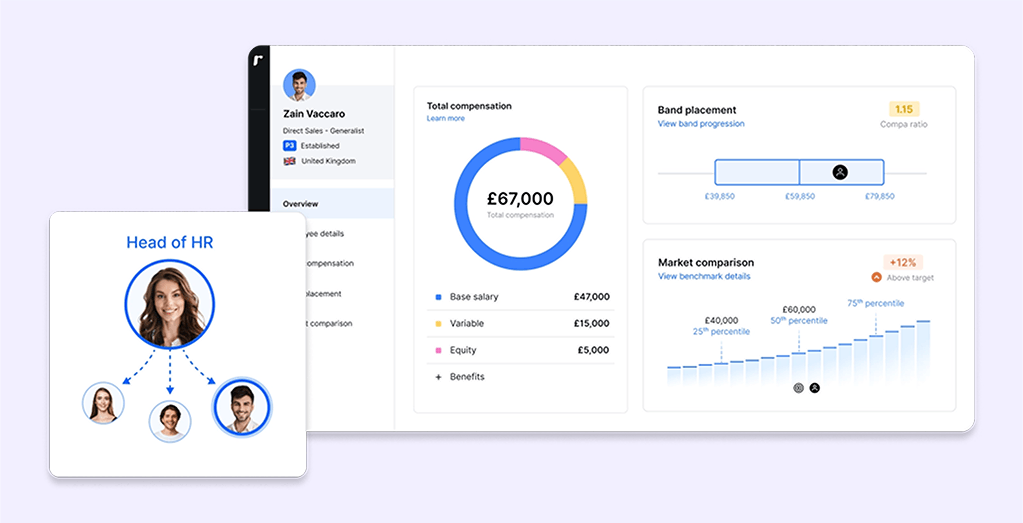Salary bands are a foundational structure for compensation management.
They’re how external benchmarking data and internal employee salary data are brought together, to ensure all employees are always paid fairly and consistently – both compared to the market and to each other – and are able to progress within their role.
Plus, they’re also a vital tool for compensation communication, especially as transparent salary ranges become the norm with new legislation like the EU Pay Transparency Directive.
All of which means that an effective salary band structure is a must.
But salary bands can easily become chaotic and hard to manage, especially for growing companies where new roles, levels, and locations are regularly being added to the mix.
So, how can People and Reward Leaders ensure a well-designed salary band structure that drives pay fairness, is easy to work with, and will grow with the company? Let’s find out.
Subscribe to our newsletter for monthly insights from Ravio's dataset and network of Rewards experts, to help you navigate a career in compensation 📩
📖 Table of contents
Part 1: What are salary bands?
Part 2: The advantages and disadvantages of salary bands
Part 3: How to create a best practice salary band structure: a step-by-step guide
- Step 1: Decide how salary bands will be grouped
- Step 2: Apply your location-based approach (if applicable)
- Step 3: Align salary bands with job levels
- Step 4: Agree the salary band midpoint
- Step 5: Agree the salary band range (or width)
Part 4: Salary band worked examples
- Salary band example 1: Software Engineer salary ranges
- Salary band example 2: Data Scientist salary ranges
Part 5: The best compensation band software in 2025
What are salary bands?
A ‘salary band’ means a defined range of salaries for a specific job role and level within a company’s structure, defining the minimum and maximum that a company will pay an employee for that role.
Salary bands are also often referred to as ‘salary ranges’, ‘pay bands’, or ‘compensation bands’ – the latter especially if companies create bands for other elements of total rewards they offer e.g. equity bands or variable pay bands.
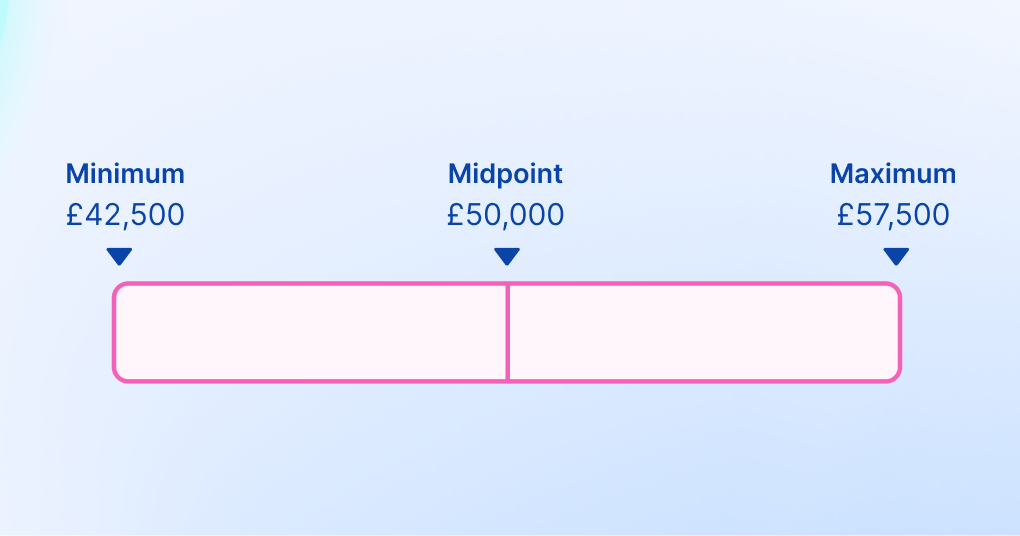
Salary bands are a foundational component of a compensation strategy, enabling fair and consistent decisions about employee compensation – both for new hire salary offers and for salary increases and promotions during compensation reviews.
There are five core elements to a salary band:
- Band group: the subset of employees whose salaries will be grouped together in a set of salary bands e.g. software engineering – ideally there should be a set of salary bands for every role within a company’s organisation structure.
- Band location: the working location of the employees who are being grouped together – ideally there should be a set of bands for each location to reflect the differences in market competitive pay across different locations (unless your company takes a location agnostic approach).
- Band level: the job level that an individual salary band covers e.g. P1
- Midpoint: the middle of the salary range, which should be the same as the market benchmark for that role, level, and location, at the company’s target percentile
- Range: the minimum (start of band) to maximum (end of band) salaries that an employee at that role, level, and location can be paid – this should align with typical employee progression.
For more detail on each of these five elements, head to the section below: How to create a best practice salary band structure: a step-by-step guide.

The advantages and disadvantages of salary bands
There are many advantages to using salary bands:
- Consistent compensation decisions
- Accurate budgeting for compensation reviews
- Fair and equitable pay
- Clear and transparent employee communication on compensation
- Defined pathways for career and pay progression.
Salary bands advantage 1: Consistent compensation decisions
Salary bands bring a formalised structure to compensation by grouping together sets of employees who perform equal work or work of equal value to ensure that they are paid consistently – both:
- Consistent to one another: All employees are paid within the same salary range for their role and level, with their specific salary within that range determined based on factors like skills, experience, tenure, etc.
- Consistent to the company’s market approach: The midpoint of each salary band aligns with the company’s target percentile which determines how competitively they will pay compared to the market, and regularly refreshing the salary bands against up-to-date salary benchmarking data ensures that competitiveness is maintained.
Through this, all decisions about compensation – from what salary to advertise for a new role to what merit increase to offer high-performers in this year’s compensation review – are well-informed and consistent, with clear rationale behind them.
Without salary bands, it would be easy for those compensation decisions to become inconsistent, as team members make ‘finger in the air’ decisions – especially because a number of different people within a company are making those decisions regularly, from talent acquisition, to line managers, to people team, to finance team, to leadership team.
This role of salary bands in ensuring fair and consistent salaries is why public sector organisations typically have standardised pay bands in place with clear expectations for each role. For instance, in the UK it’s easy to find information on salary bands for the NHS, Met Police, BBC, TFL, as well as government departments like ONS or Defra.
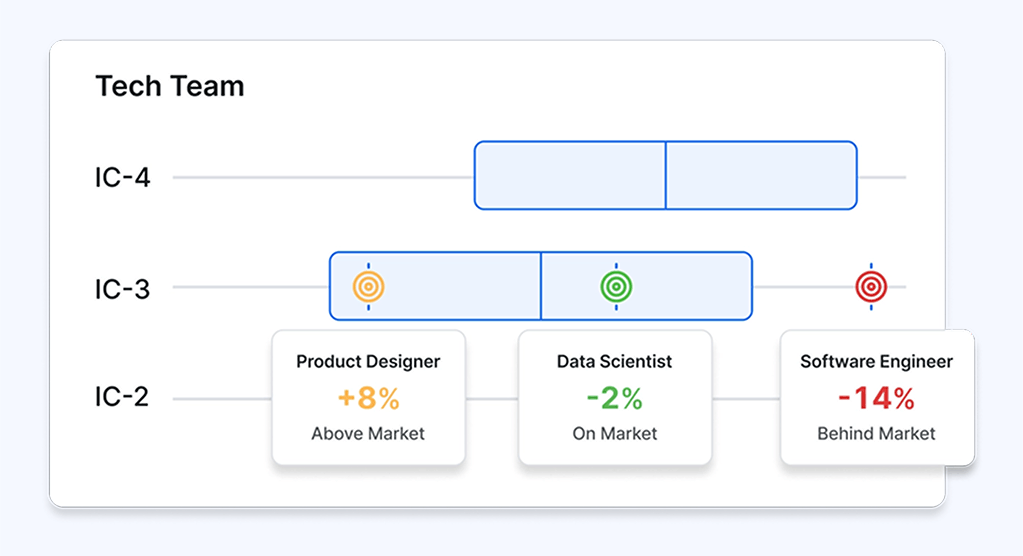
Salary bands advantage 2: Accurate budgeting for compensation reviews
Payroll is typically one of the biggest costs in a company, and a lack of clarity on compensation decisions can make budget planning with finance colleagues difficult.
With salary bands, payroll budgeting becomes much easier:
- New hires: salary bands bring consistency to salary offers which makes it possible to forecast costs for planned hires
- Pay progression and performance reviews: expected pay progression is built into the salary band via the range (minimum to maximum), making it easy to model expected costs of compensation increases for existing employees.
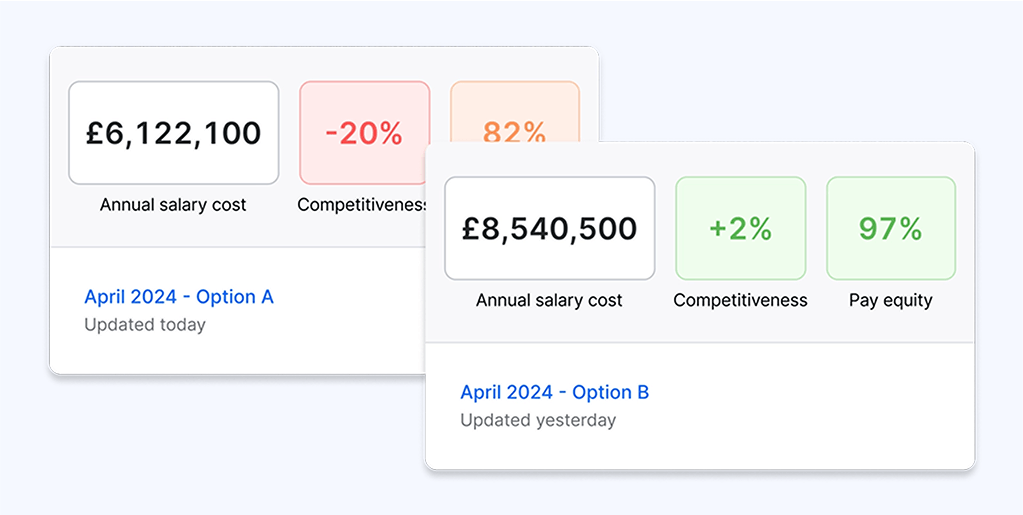
Salary bands advantage 3: Fair and equitable pay
Through salary bands employees who perform equal work (or work of equal value) should be grouped together based on role, level, and location, to ensure they are paid consistently.
Therefore, with a clearly defined set of salary bands in place, it’s easy to identify when fairness may be damaged:
- Salary band outliers i.e. employees paid above or below their band arise, indicating that there is some inconsistency across compensation packages that needs to be addressed to maintain fairness
- Pay equity disparities e.g. all female software engineers are in the lower quartile of their band, indicating that bias or discrimination is causing inconsistencies.
Plus, we also know that pay equity typically arises at the point of hiring – having a clear salary band structure which talent acquisition and hiring managers adhere to helps to eliminate any subjectivity and bias which may take place during the salary offer and negotiation process.
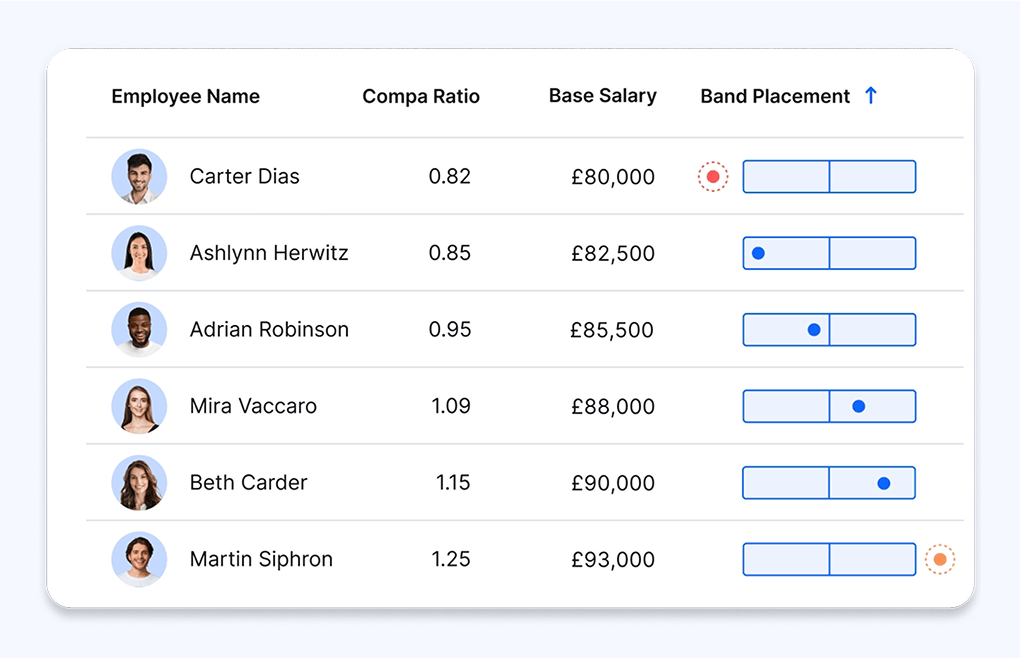
Salary bands advantage 4: Clear and transparent employee communication on compensation
A clearly defined salary band structure makes communicating compensation with employees much easier at every stage.
For job candidates, having the salary band for the role ensures that salary expectations are clear. For new hires, it means understanding how the salary offer they’ve received fits within the salary band for the role. And for existing employees, it means knowing where they sit in their salary band, what the likely career and pay progression is within their role, and the expectations for moving to the next salary band (and job level).
Great employee communication on compensation is tied to business outcomes too, because when employees understand their compensation better they’re more likely to feel fairly compensated. That increases motivation and engagement, reducing attrition.
Plus, pay transparency laws like the EU Pay Transparency Directive are soon coming into effect, which will make it mandatory to inform job candidates of the salary range for a role and to implement transparent communication on salary bands and progression pathways for employees.
Salary bands advantage 5: Defined pathways for career and pay progression
Salary bands are fundamental for career and pay progression.
A company’s level framework lays the foundation for the competencies employees need to demonstrate to progress through a job level, and then to be promoted to the next level.
Salary bands then define how the salary will increase as the employee progresses through their band and onto the next – as well as how this progression might differ for different departments or job positions.
The clarity that this structure brings makes it much easier to handle compensation review decisions and conversations.
Salary bands disadvantage 1: Complex to manage and maintain
The one major disadvantage of salary bands is that they can feel complex.
In a best practice world there should be a salary band for every job position and level in your company, plus every location too if you compensate employees differently based on location.
That means a lot of salary bands to build and maintain – and to ensure are being used correctly across different teams and line managers.
Historically, Reward Leaders have used Excel to manage their salary band structure, which only adds to the complexity.
However, with salary band tools like Ravio’s on the market today, it’s now possible to create, visualise, edit, refresh, and share bands effortlessly – removing that disadvantage from the equation.
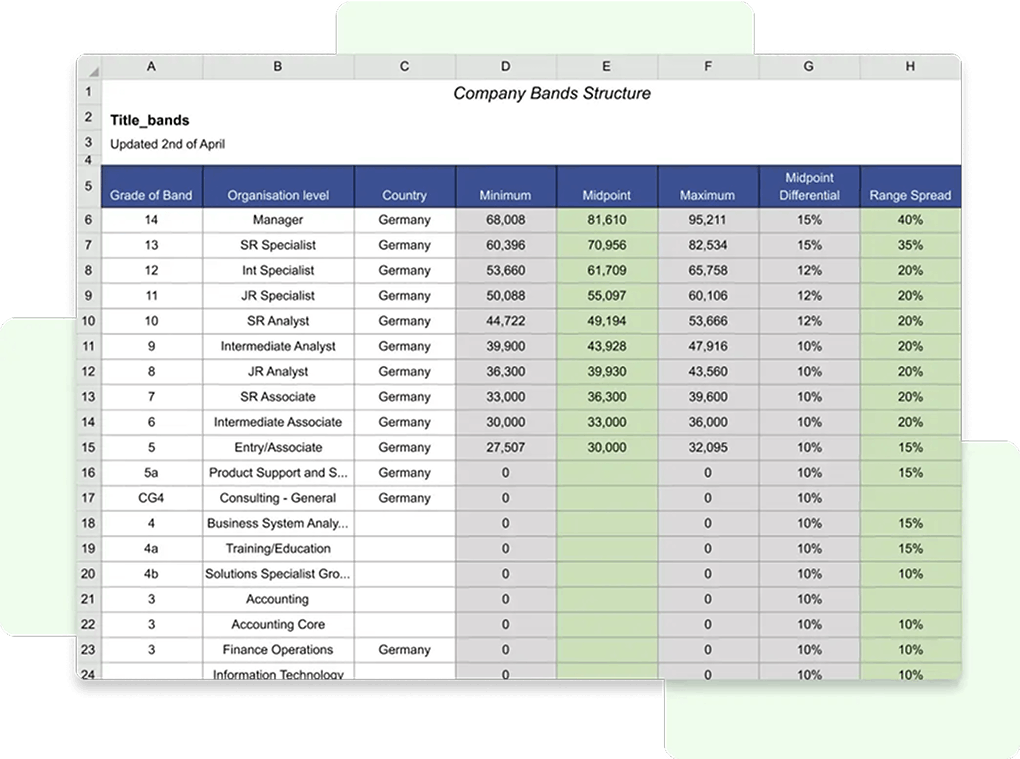
How to create a best practice salary band structure: a step-by-step guide
As we’ve seen, it’s important to ensure well-designed salary bands to enable those fair, consistent, competitive compensation decisions.
So how do you do that?
Well, it comes down to deciding how to approach those five core components of a salary band structure that we saw earlier: band group, location, level, midpoint, and range.
Step 1: Decide how salary bands will be grouped
The band group defines how a company ‘groups’ their employees together within salary bands, i.e. which employees should be receiving comparable compensation packages.
There are three typical approaches to grouping salary bands.
The first approach is to have a set of salary bands for the whole company.
In this scenario there is just one salary band group for the entire team, with individual bands based on job level.
This may be the simplest option, but it is not best practice due to the variance in market competitive compensation across different departments and roles, which inevitably means that when all employees are grouped together, some will be paid unfairly.
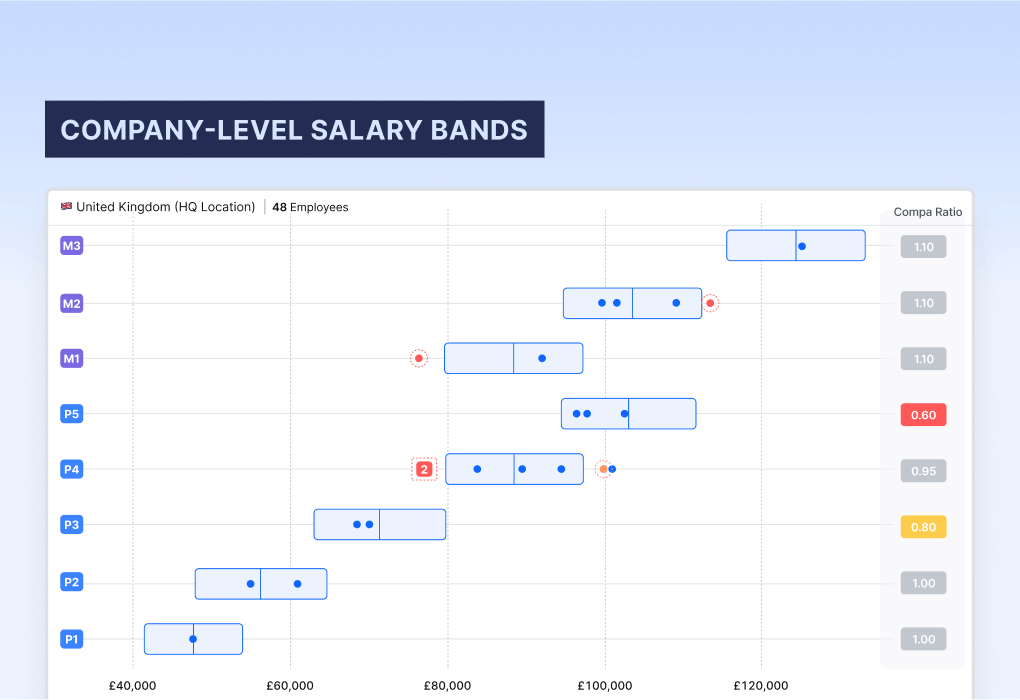
Secondly, companies might opt for a structure with a set of salary bands for each department.
Here, salary bands are grouped by department e.g. a salary band group for the Software Engineering function with individual bands based on job level – and a separate band group for the Sales function, and so on.
This is the most common approach to band groups, and does ensure that any difference in approach between departments can be reflected, as well as the variance in competitive compensation between job functions.

Finally, a set of salary bands for each role.
In this structure, salary bands are grouped by role, so there is a set of bands for each job position within the company’s taxonomy, with individual bands for each job level within that role.
This is the best practice approach to ensure the variance in market competitive compensation between roles is fully reflected in compensation decisions.
However, especially for larger companies, it does mean that there are a lot of salary bands to manage, which can make some companies prefer a department-level approach.
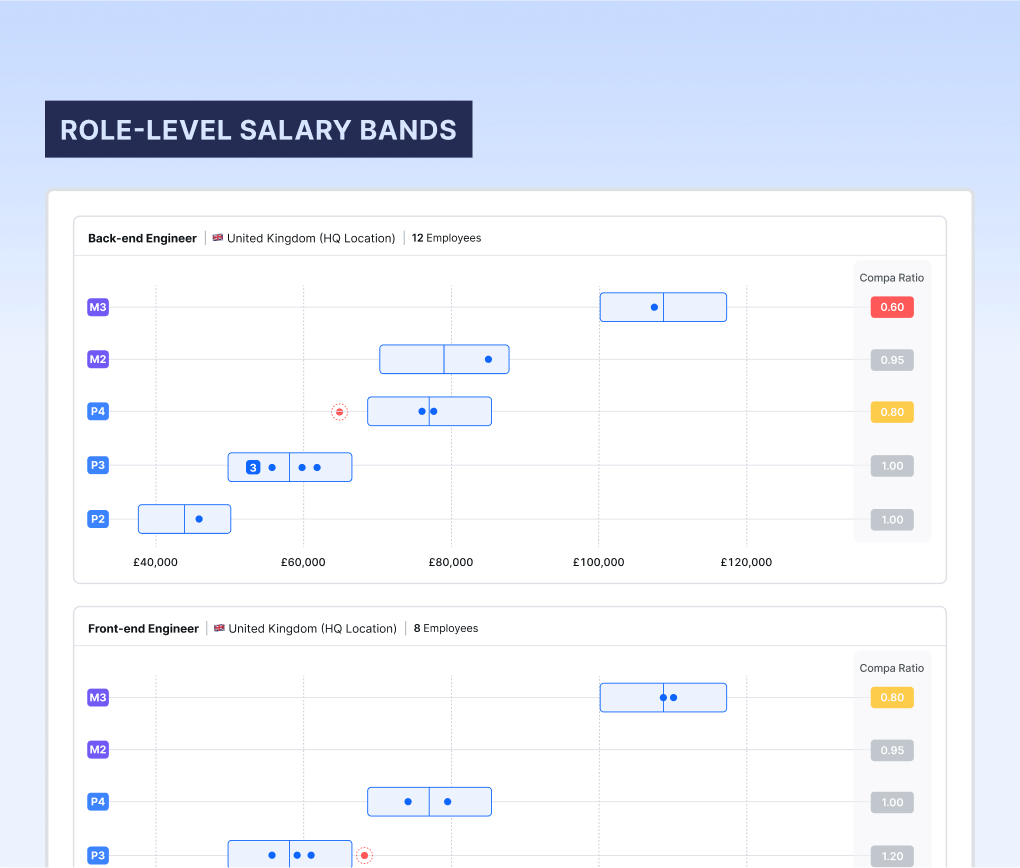
💡 Why is it best practice to have a set of salary bands for each different job role?
The ideal scenario with a salary band structure is to have a set of salary bands for every job position in a company’s entire organisation structure – including any roles that don’t yet exist, but plan to be hired in the future.
This is because fair compensation differs significantly across roles, even when those roles are within the same function.
For instance, it’s common for Product Managers and Product Designers to be grouped together, when they’re actually very different roles and can have very different salaries. The same is true with the many different types of Software Engineering, especially new and trending types such as AI or Prompt Engineering.
If these roles are bundled together in one set of salary bands, you’ll need a much bigger range to reflect the difference in salaries, and you’ll quickly see inconsistencies and outliers arise – which makes it very difficult to ensure compensation decisions are always fair across the team.
Plus, as the company grows and teams become larger, a department-level band structure can become very crowded and difficult to manage, with hundreds of employees represented in one set of bands.
Having a set of salary bands for every job role makes it very easy to fairly compensate any employee in any job position at any level – because you have a clearly defined structure for how they should be paid.
Our suggestion would be to:
- Start with department-level salary band groups
- Split out job roles into their own salary band group as the company grows – prioritising roles that are inconsistent with others in their department (e.g. Product Manager vs Product Designer)
- Aim to eventually have a set of salary bands for each individual job position in place for maximum consistency and fairness.
Step 2: Apply your location-based approach (if applicable)
The approach to compensation per employee location is a key component of any compensation philosophy today – with the increase in remote and hybrid working.
Some companies decide to pay employees differently based on their location, to ensure variances in market competitive compensation and cost of living are reflected in the approach. Others opt for a location agnostic approach, paying all employees based on the market benchmarks for the company’s HQ location.
If you do have a location-based approach to compensation, this needs to be reflected in your salary band groups too – with a different group for each key location.
For instance, if you’ve opted for department-level salary band groups and in Software Engineering you have employees based in several locations in Europe, then you’ll need a salary band group for UK Software Engineering, France Software Engineering, Bulgaria Software Engineering – and so on.
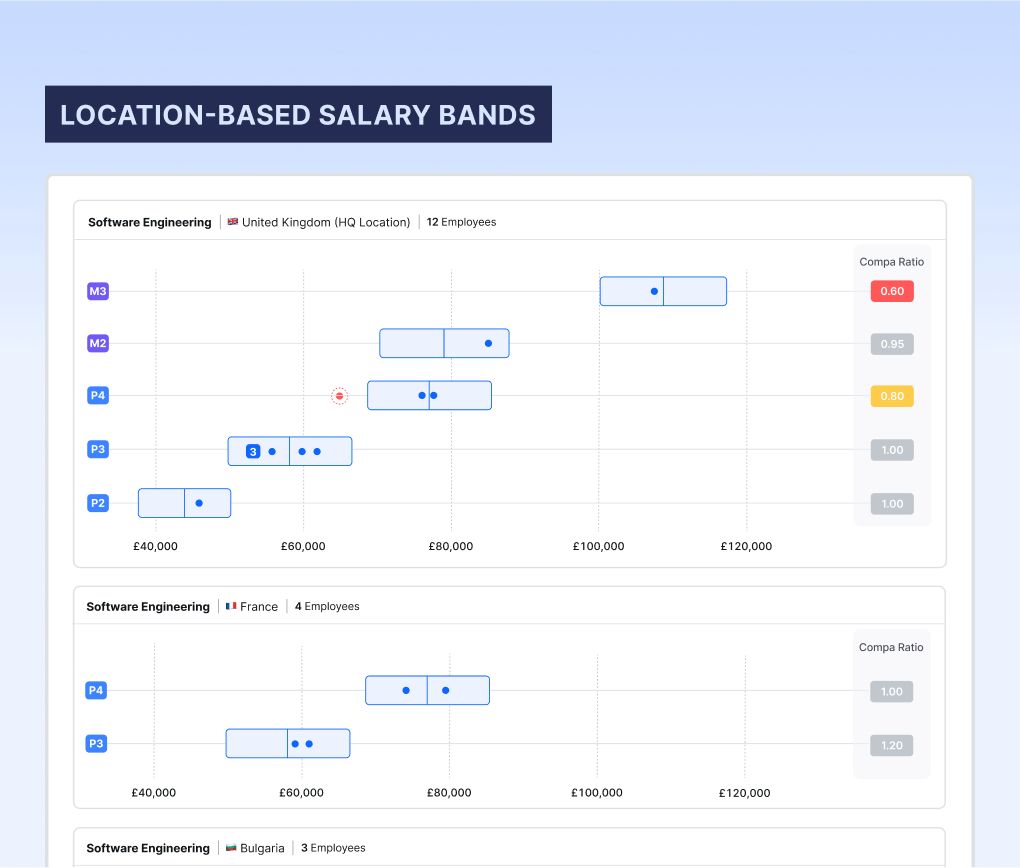
Step 3: Align salary bands with job levels
The individual salary bands within salary band groups will always be based on job level, regardless of which structure you opt for.
Having a salary band per level is vital because compensation varies depending on seniority level – so the salary range for each level naturally needs to be different.
So, the next step is to align the salary band structure with your level framework.
Each band group needs a separate salary band within it for each job level that is relevant to that group.
For instance, if you have department-level and location-level salary bands then within the Software Engineering band group you’ll then need an individual salary band for P1, P2, P3, P4, and so on.
Step 4: Agree the salary band midpoint
At this point, you have the core structure for your salary bands – the overarching salary band groups, and the individual bands needed for each level within the groups.
The next step is determining what the salary range for each individual salary band should actually be.
First up, the midpoint.
The midpoint is the middle of the salary range for an individual band.

In best practice, the midpoint should always be the same as the company’s target percentile for the job position or department that the salary band reflects.
So, for instance, if the company targets the 50th percentile to ensure that employee compensation is always market-aligned, then the midpoint of each salary band should reflect the market median salary for the role.

For some companies the target percentile differs depending on job function or role. For instance, it’s common for tech companies to target the 75th percentile for Software Engineers to compete in the market for priority talent, whilst commercial roles might be compensated at the 50th percentile. If that’s the case, it needs to be reflected within the midpoint of each band – so in this example, the salary band midpoint for Software Engineers should instead reflect the market benchmark for the 75th percentile.
Of course, it’s crucial to have access to reliable salary benchmarking data from a trusted provider for this step.
To receive the latest insights on compensation straight to your inbox, subscribe to our monthly newsletter 📩
Step 5: Agree the salary band range (or width)
With the midpoint of each salary band defined, the final step is to decide the range or width of each salary band i.e. the minimum to maximum amount that an employee within that band can be paid for their work.

The range should reflect expected pay progression for that group of employees.
As an employee gains skills and experience in their current role, their pay should be able to progress within their band – before they are eventually promoted to the next level (and salary band).
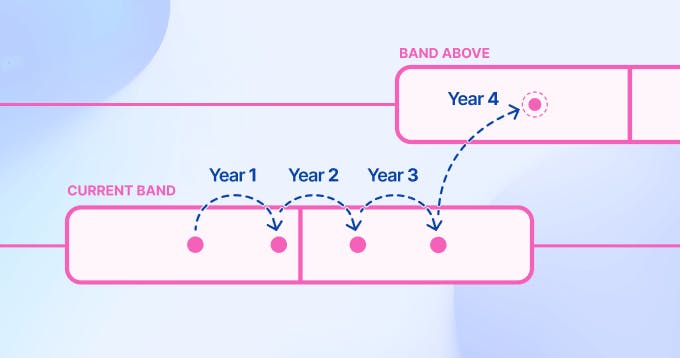
The range, therefore, differs depending on a company’s level and career progression frameworks, to reflect actual expected employee progression rates.
💡 How is salary band progression measured?
There are two main ways to measure an employee’s progression within their current salary band, both looking at band position:
- Salary range penetration calculates how far through the salary range the employee’s current salary is. For instance, if the range for a band was £42,500-£57,500 and an employee’s salary was £51,350 then the salary range penetration would be 0.59 or 59%.
- Compa ratio compares an employee’s current salary to the midpoint of the salary band. Using the same example, for instance, then if the midpoint of the band was £50,000 then the employee would have a compa ratio of 1.027 – slightly above midpoint.
Get a free salary band progression calculator >

The best practice for salary range spread is around 15% either side of the midpoint.
This typical spread reflects a typical career progression of roughly 3-5 years for an employee to be promoted to the next level, with an annual salary increase of around 5% within their current role – bearing in mind that it’s rare for an employee’s starting salary to be the absolute minimum for their band, or for their end salary before promotion to be the absolute maximum of their band.
However, some companies will opt for a wider or more narrow band, depending on typical progression.
If the band is too narrow, then outliers can quickly arise where employees are paid above or below the band.
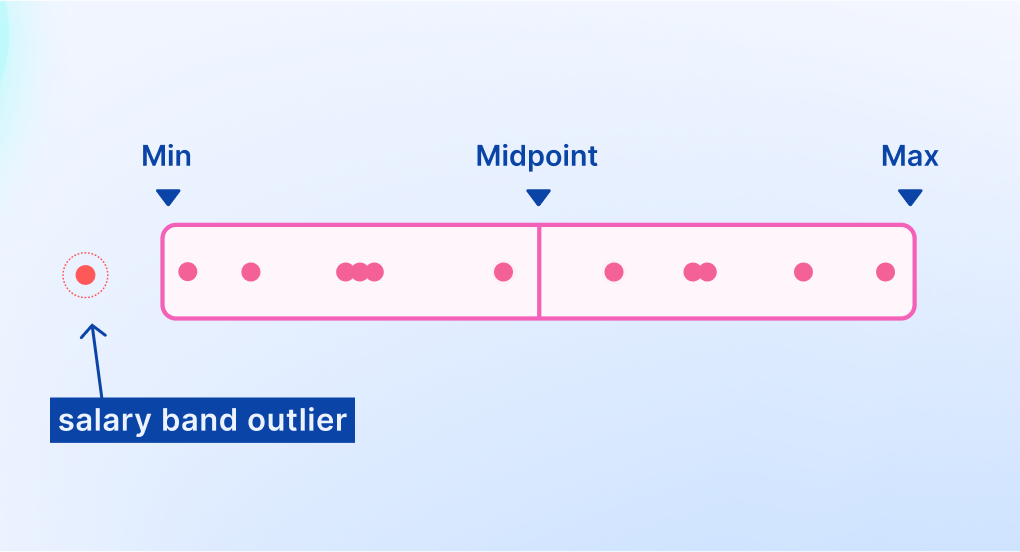
The range can also vary between different roles or levels.
For instance, it’s typical for career progression to be much quicker in the early stages of a career (e.g. levels P1 or P2) as skills and experience ramp up more quickly. In the later stages of a career, progression becomes much slower, and it's common for employees to stay within one level and one band for much of their career. Therefore, some companies will have a wider range for more senior job levels to ensure pay progression remains possible within their band.
💡 What about total compensation bands?
The steps we’ve outlined above focus on ‘salary’ bands as a way to manage base salary for all employees.
However, of course, many companies also include equity compensation and / or variable pay within an employee’s compensation package.
Therefore, they may want to also set up equity bands, variable pay bands, or total compensation bands – a great way to ensure fair and consistent decisions across all elements of compensation.
The process is essentially the same, but will need to incorporate the company’s approach to rewarding equity and variable compensation, as well as reliable market benchmarking data for those components too.
This can be particularly tricky with equity because companies award equity to employees in such varying ways and the value of that equity also varies significantly depending on the company (e.g. private vs publicly listed). For more advice on this go to ‘Step 8: Build equity compensation bands’ in our equity compensation guide.

Salary band worked examples
It’s always helpful to see how creating salary bands actually works in practice, so let’s take a look at a couple of worked examples.
Salary band example 1: Software Engineer salary ranges
Let’s say a company is creating salary bands for their Software Engineering department.
We want the bands to be for the department as a whole, but we do want to differentiate on location. Our HQ is in London, UK and we pay HQ-based employees using London benchmarks but employees based remotely on ‘UK all’ benchmarks – so we need one Software Engineering band group for London and one for all other locations.
We want to build a salary band for every possible job level within the Software Engineering function to future-proof the bands.
Our target percentile for Software Engineers is the 75th percentile, because a core element of our compensation philosophy is the need to attract and retain top tech talent to build our software product.
We use Ravio’s salary benchmarking data to determine the midpoints for each salary band.
For instance, the 75th percentile salary for a P3 Software Engineer (generalist) in London is £79,300 (as of February 2025) – so that’s the midpoint for our P3 band in the HQ / London band group.
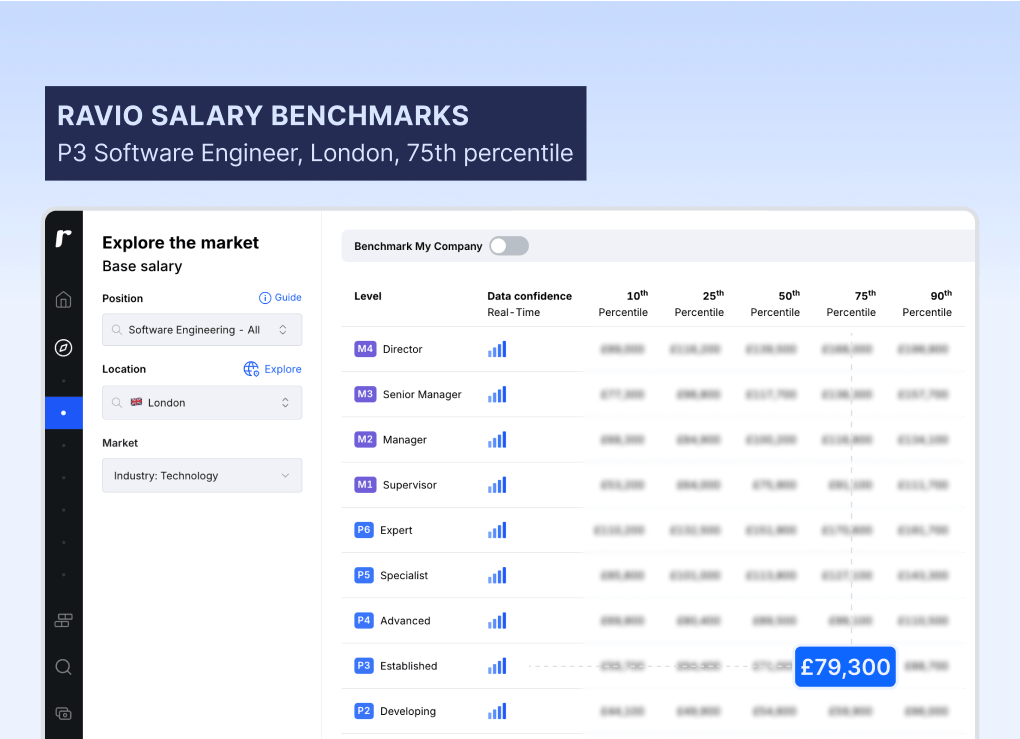
We want our salary bands to have a fairly standard width but allow for employees to see a decent amount of pay progression within their current role, so we set the range as 20% either side of the midpoint.
For the same P3 London-based Software Engineer band, that gives us the following salary range:
- Minimum: £63,440
- Midpoint: £79,300
- Maximum: £95,160
Once we’ve done this for each job level across both London and outside of London, we have our full set of Software Engineering salary bands, ready to go.
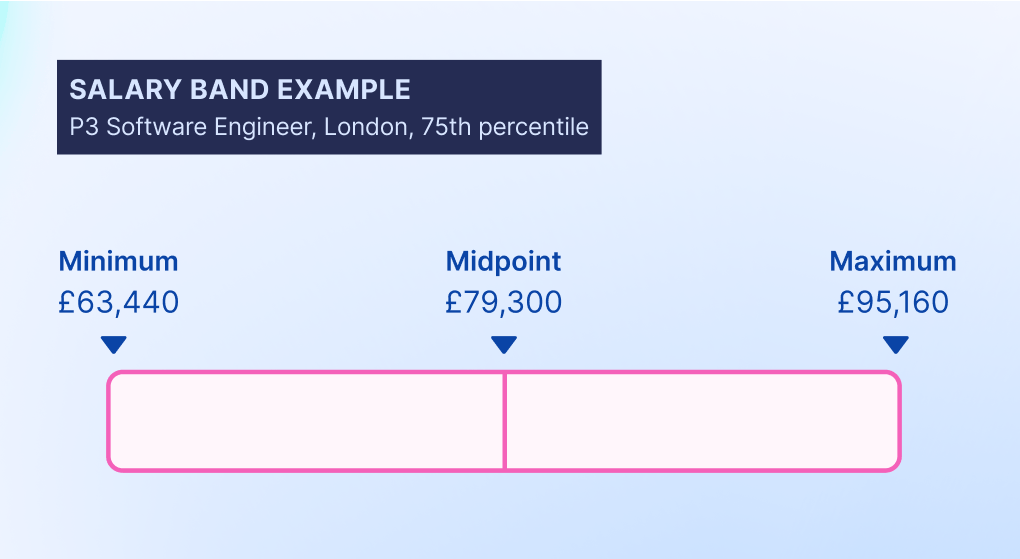
Salary band example 2: Data Scientist salary ranges
For a second example, let’s take a company that wants to build role-specific salary band groups and is starting with the salary ranges for their Data Scientist role.
It’s an important role because the company is a data company, so all Data Scientists are based in the company’s HQ in Berlin – so there’s no need to create multiple band groups for different locations in this case.
The company is relatively early-stage and currently has three Data Scientists: one at P3, one at P4, and the team manager at M3. However, they are intending to hire two entry-level P2 positions in the next year to support workload needs.
These will be the only relevant job levels for the foreseeable future so to avoid complexity we won’t build bands for the missing levels – but the company does want to support employee progression, so it’s important to also build bands for the levels immediately above where current employees are to inform promotion conversations (so P2, P3, P4, P5, M3, M4).
The company’s compensation philosophy includes the core principle of offering market-aligned salaries and market-leading equity compensation, so the target percentile for our Data Scientists is the 50th percentile.
Looking at Ravio’s salary benchmarking data we can determine what the midpoint of each salary band should, therefore, be for our target percentile in Berlin. To take one example, for the P3 Data Scientist the 50th percentile market salary in Berlin is €74,700 (as of February 2025) – so that’s the midpoint of their salary band.
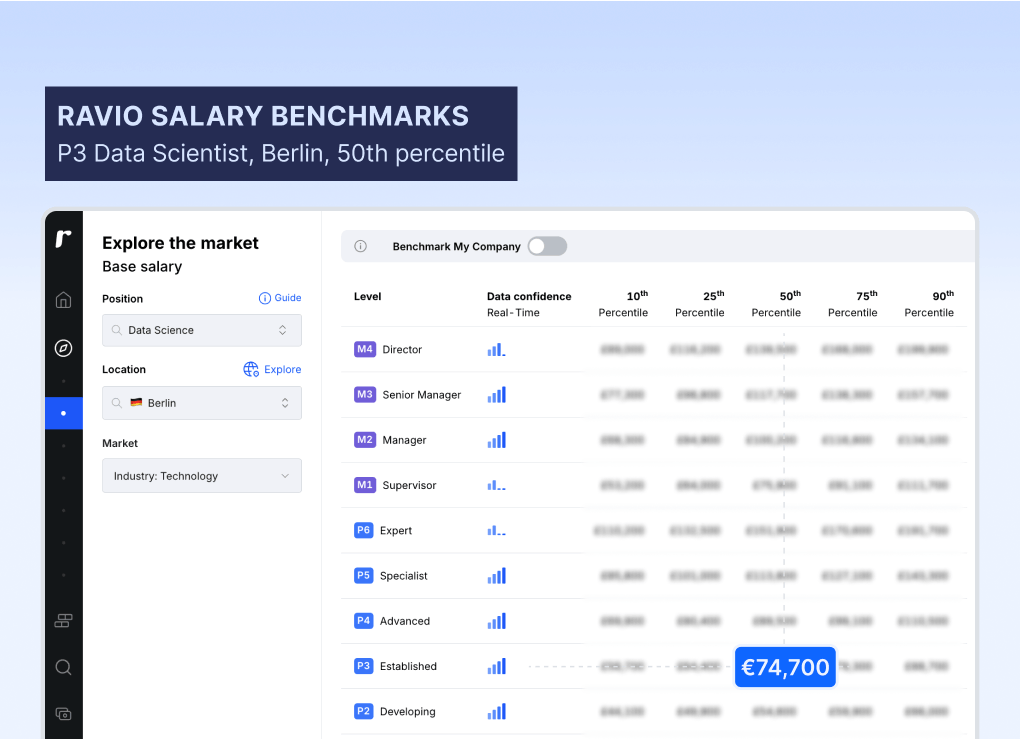
There isn’t a huge amount of payroll budget available for future salary increases currently due to the early-stage of the company, so we keep the range of the salary bands relatively narrow to manage costs, at 10% either side of the midpoint.
For the P3 Berlin-based Data Scientist, that gives us the following salary range:
- Minimum: €67,230
- Midpoint: €74,700
- Maximum: €82,170
Now we replicate this for all the levels we need to reflect, and we have our Data Scientist salary ranges, ready to go.

The best compensation band software in 2025
As we’ve seen, compensation bands are a foundational element in an organisation’s compensation strategy, especially when it comes to ensuring fair and consistent pay decisions are made for all employees.
But managing salary bands is also a notoriously difficult task for People and Reward Leaders.
Traditionally, Reward teams have used Excel to create and manage their salary bands, which can quickly become chaotic – especially if you have a structure with lots of different bands for departments or roles.
It’s particularly challenging when it comes to refreshing salary bands to align with up-to-date benchmarking data during compensation reviews. The team has to manually go through each salary band in the excel sheet, update the midpoint and range, and highlight where employees may need a market adjustment to maintain fair pay.
Plus, when multiple people are using the same spreadsheets, errors and typos come up all the time – which can be hugely damaging if it leads to mistakes with employee compensation.
On top of all that, with the need for transparent communication with employees rising, managing salary bands in Excel makes it hard to share information on salary bands with the team too – sharing a mammoth spreadsheet can be incredibly overwhelming.
However, there is an alternative.
Ravio’s salary bands tool makes it easy to view, analyse, refresh, and share salary bands that are continuously calibrated against reliable and real-time benchmarking data.
How Ravio’s salary band tool makes creating and managing salary bands a simple task
Building a salary band structure from scratch is effortless with Ravio.
All you need to do is tell us the principles behind how you’d like your bands set up, and we automatically create the band structure for you – which is then fully editable if you want to make any changes.
If you already have salary bands set up and want to use Ravio to get them out of Excel and into a platform where they can be visualised against live market data, then you can simply import your existing band structure to Ravio.
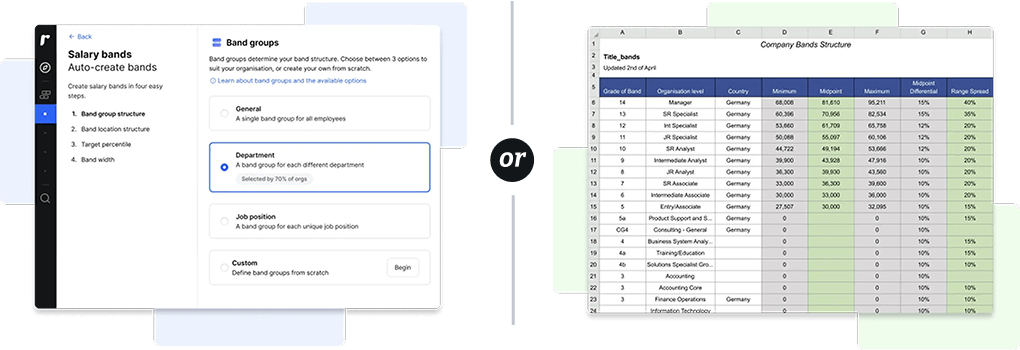
Once your salary bands are set up it’s then easy to make changes to how bands are grouped, edit the target percentile, or refresh the band midpoint and ranges to align with the latest market benchmarks.
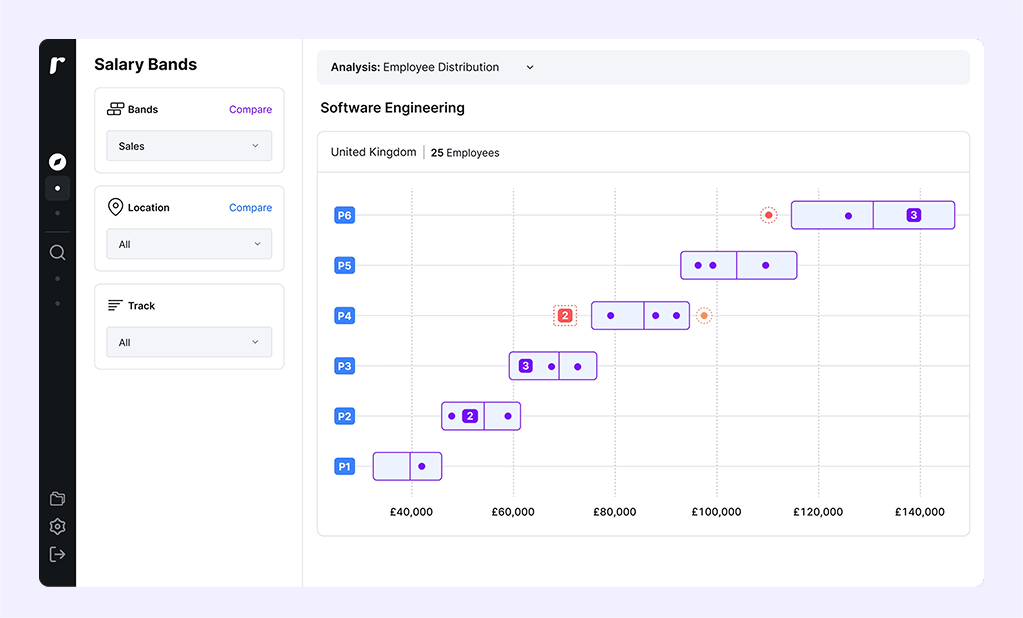
Plus, you’ll also be able to easily identify any pay issues that need to be addressed – band outliers who are falling behind the market, or potential pay equity issues such as female employees tending to be in the lower quartile of their band.

Salary bands can also be shared from the Ravio platform, both with line managers or talent acquisition colleagues to support compensation decisions, and with employees to help them understand the logic behind their pay.
